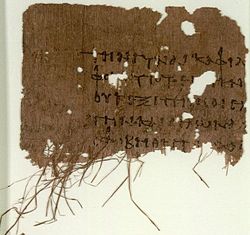Papyrus 103
New Testament manuscript From Wikipedia, the free encyclopedia
Papyrus 103 (in the Gregory-Aland numbering), designated by 𝔓103, is a copy of part of the New Testament in Greek. It is a papyrus manuscript of the Gospel of Matthew.
| New Testament manuscript | |
 | |
| Name | P. Oxy. 4403 |
|---|---|
| Sign | 𝔓103 |
| Text | Gospel of Matthew 13:55-56; 14:3-5 |
| Date | 2nd / 3rd century |
| Script | Greek |
| Found | Oxyrhynchus, Egypt |
| Now at | Sackler Library |
| Cite | J. D. Thomas, OP LXIV (1997), pp. 5-7 |
| Size | [16] x [11] cm |
| Type | Alexandrian text-type |
| Category | I |
Description
The surviving texts of Matthew are verses 13:55-56 and 14:3-5: they are in a fragmentary condition. The manuscript has been assigned palaeographically to the late 2nd or early 3rd century.
Probably together with Papyrus 77 it belonged to the same codex.[1]
- Text
The Greek text of the codex is a representative of the Alexandrian text-type. According to Comfort it is proto-Alexandrian text.[1]
In Matthew 13:55, the name of Jesus' second brother reads [...]ης so that either Ἰωάννης (John) and Ἰωσῆς (Joses) are possible original readings.
- Ἰωάννης (John) א* D M U Γ 2 28 579 1424 Byzmss vgmss Origenpt
- Ἰωσῆς (Joses) K L W Δ Π 0106 f13 22 565 1241 1582mg Byzmss itk,qc cosa,bomss Basil of Caesarea
- Ἰωσῆ (Joses) 118 157 700* 1071 syrh cobomss
- Ἰωσὴφ (Joseph) א2 B C N Θ f1 33 700c 892 lat syrs,c,hmg mae-1 Codex Schøyen cobomss Origenpt
- Location
The manuscript is currently housed at the Sackler Library (Papyrology Rooms, P. Oxy. 4403) in Oxford.[2]
See also
References
Further reading
External links
Wikiwand - on
Seamless Wikipedia browsing. On steroids.
